If you love orchids but hate fussy plants, these low-maintenance orchids may be the houseplants for you!
Orchids are some of the most popular houseplants around and are well-known for their colorful flowers and intriguing growth habits. But among plant parents, orchids are rather notorious for being difficult to keep. But that’s not necessarily true!
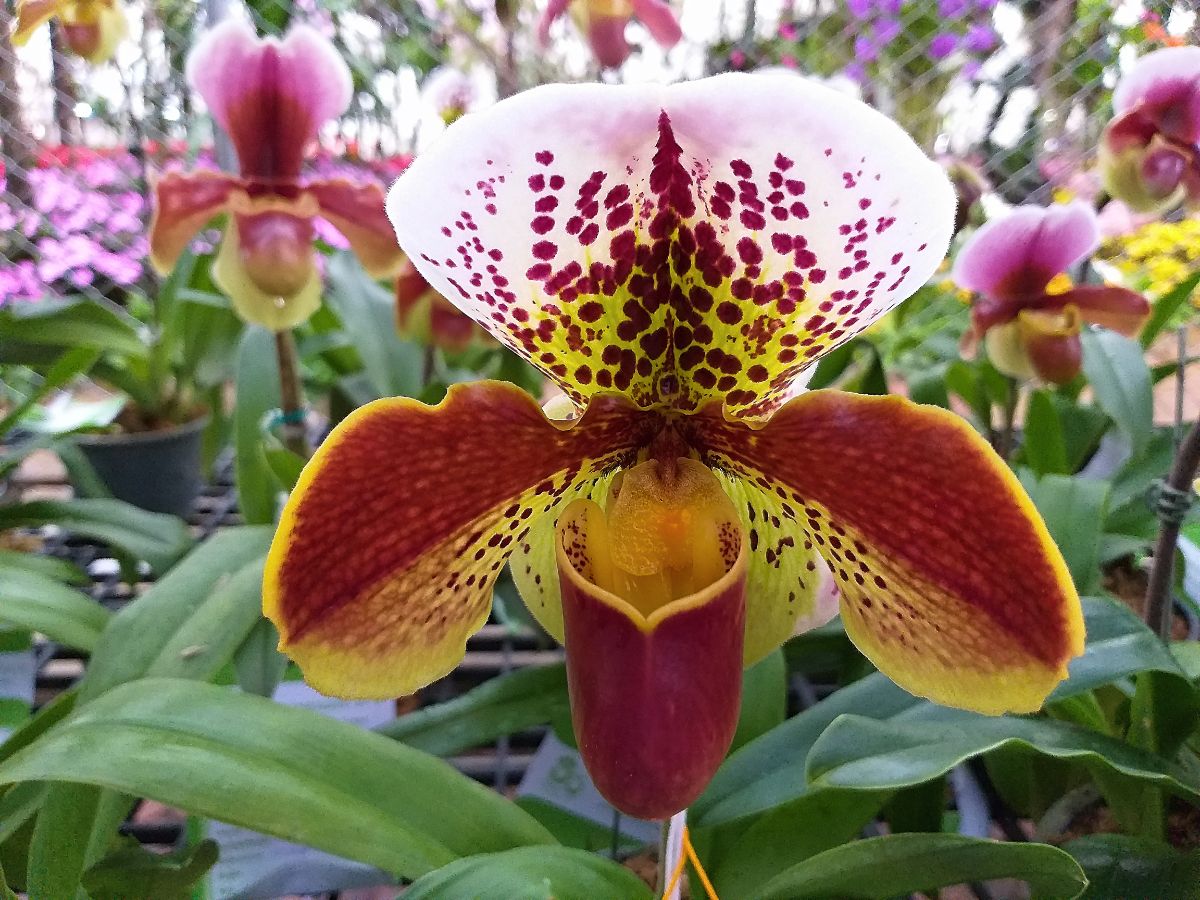
There are over 28,000 different species of orchids, ranging from the common moth orchid to the very rare (and expensive!) Rothschild’s orchid. With all that variety, there are a lot of orchids to choose from, and there’s a surprising number of orchids that are very low maintenance and require about the same care as most tropical houseplants.
In this guide, we’ll introduce you to some of the best beginner-friendly orchids that are easy to maintain, even if you’re new to orchids!
Jump to:
- 18 easy to care orchids for beginners
- 1. Moth Orchid (Phalaenopsis spp.)
- 2. Cattleya Orchid (Cattleya spp.)
- 3. Lady of the Night Orchid (Brassavola nodosa)
- 4. Nun’s Orchid (Phaius tancarvilleae)
- 5. Dendrobium Orchid (Dendrobium spp.)
- 6. Slipper Orchid (Paphiopedilum spp.)
- 7. Jewel Orchid (Ludisia discolor)
- 8. Cockleshell Orchid (Prosthechea cochleata)
- 9. Boat Orchid (Cymbidium spp.)
- 10. Pansy Orchid (Miltonia spp.)
- 11. Reed Orchid (Epidendrum spp.)
- 12. Butterfly Orchid (Psychopsisspp.)
- 13. Dancing Lady Orchid (Oncidium spp.)
- 14. Bulbophyllum Orchid (Bulbophyllum spp.)
- 15. Odontoglossum Orchid (Odontoglossum spp.)
- 16. Spider Orchid (Brassia spp.)
- 17. Christmas Orchid (Calanthe spp.)
- 18. Aspasia Orchid (Aspasia spp.)
- Frequently asked questions
- Summary
18 easy to care orchids for beginners

In the list below, we’ve compiled some of the easiest and prettiest orchids around. Many of these orchids are super simple to keep and can be purchased at many garden centers or online. If you’re just starting out with orchids, we recommend you try out some of these easier orchids before graduating to the trickier and more demanding members of this colorful plant family.
1. Moth Orchid (Phalaenopsis spp.)
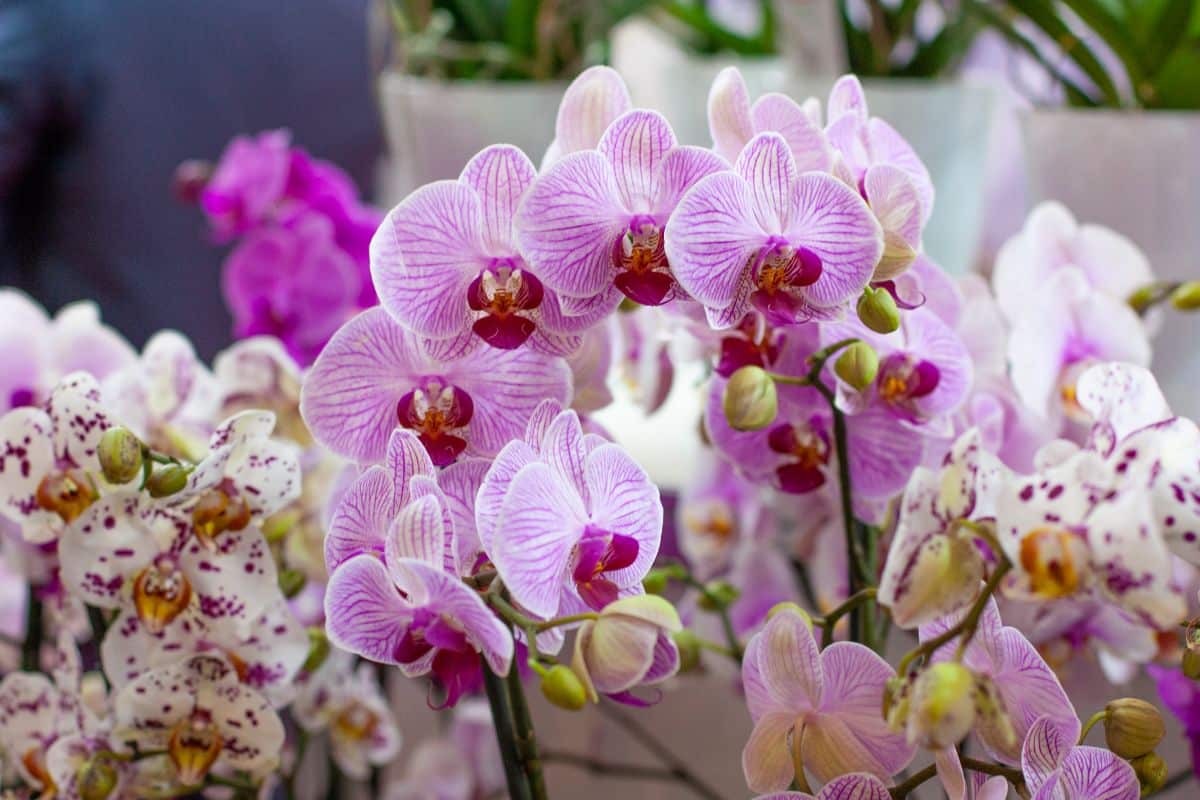
| Plant name: | Moth orchid |
| Type of orchid: | Epiphyte |
| Lighting requirements: | Bright, indirect light |
| Watering requirements: | Moderate |
| Minimum humidity level: | 40 to 60% |
If you visit your local plant nursery and you see some orchids for sale, there’s a good chance that they’re moth orchids. These easy-going plants are some of the most popular orchids around, and they grow very well in homes. They are also well-known for their colorful flowers that come in many different colors, including bright green, pink, white, and purple.
Moth orchids are native to Asia and Australia, where they grow as epiphytes, like many other orchid types. As houseplants, they don’t grow well in soil but prefer to be potted in a well-draining orchid potting mix. These plants grow best in bright, indirect sun and can become sun damaged if they are kept in too much bright light.
2. Cattleya Orchid (Cattleya spp.)
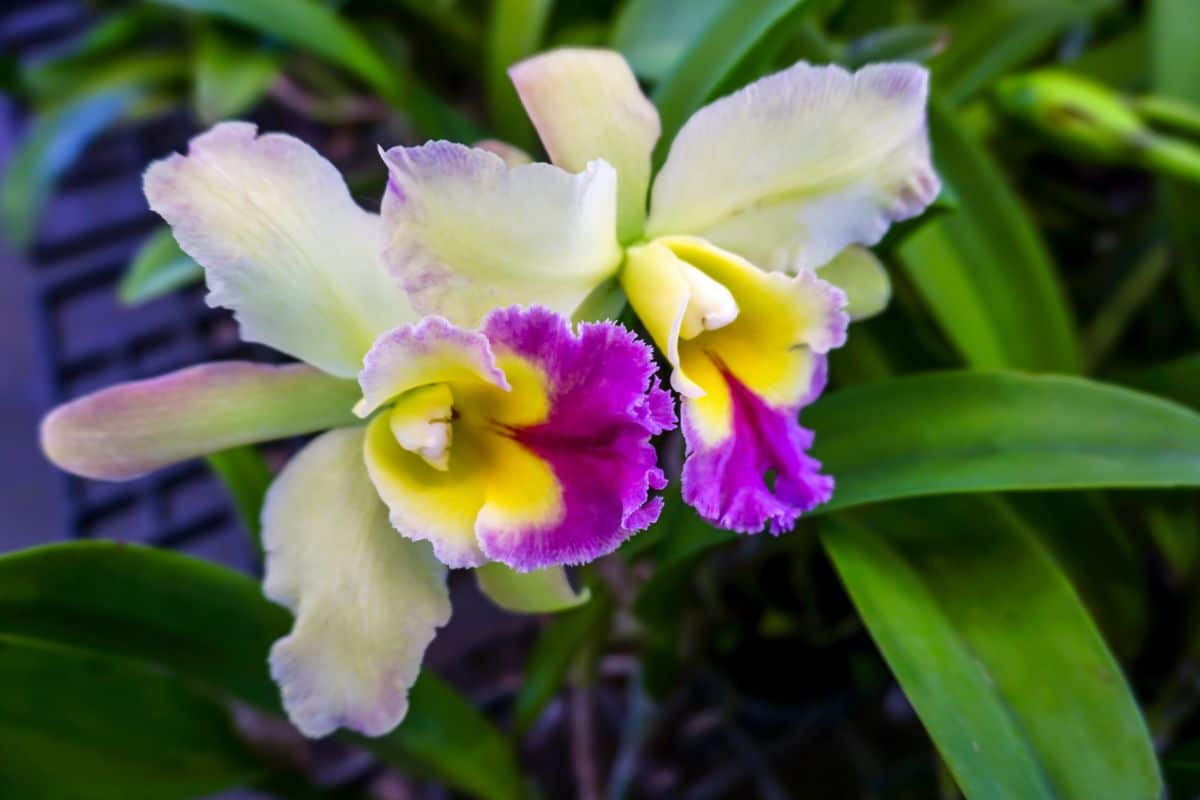
| Plant name: | Cattleya orchid |
| Type of orchid: | Epiphyte |
| Lighting requirements: | Bright, indirect light |
| Watering requirements: | Moderate |
| Minimum humidity level: | 50 to 80% |
Another common orchid variety, cattleyas are generally easy to find at garden centers. Well known for their vibrant and showy flowers, flower shapes and colors can vary significantly, and some cattleya blooms can measure several inches long.
Cattleya orchids are native to Brazil, and they were first written about by the English horticulturalist William Cattley, for whom they’re named. Indoors, cattleya orchids grow best in indirect light, and they should be provided with a bit of extra humidity to avoid leaf cracking. Many growers choose to keep cattleya orchids on top of a pebble tray to make sure they receive adequate humidity.
3. Lady of the Night Orchid (Brassavola nodosa)

| Plant name: | Lady of the Night orchid |
| Type of orchid: | Epiphyte |
| Lighting requirements: | Bright to bright, indirect light |
| Watering requirements: | Moderate |
| Minimum humidity level: | 50 to 70% |
Lady of the night is a very attractive and unique-looking orchid that can adapt to a range of conditions, making it well-suited for beginners. The heart-shaped flowers most often have solid white petals; however, some varieties can also exhibit ornamental spotting on the petals as well. When in bloom, these orchids are highly aromatic and have a citrus-like fragrance.
Lady of the night orchids are native to Central and South America, where they grow as epiphytes on trees and rocks. Indoors, they can tolerate some direct light, and their tubular leaves aid in water conservation, so they don’t need as much humidity as some other orchid varieties.
4. Nun’s Orchid (Phaius tancarvilleae)
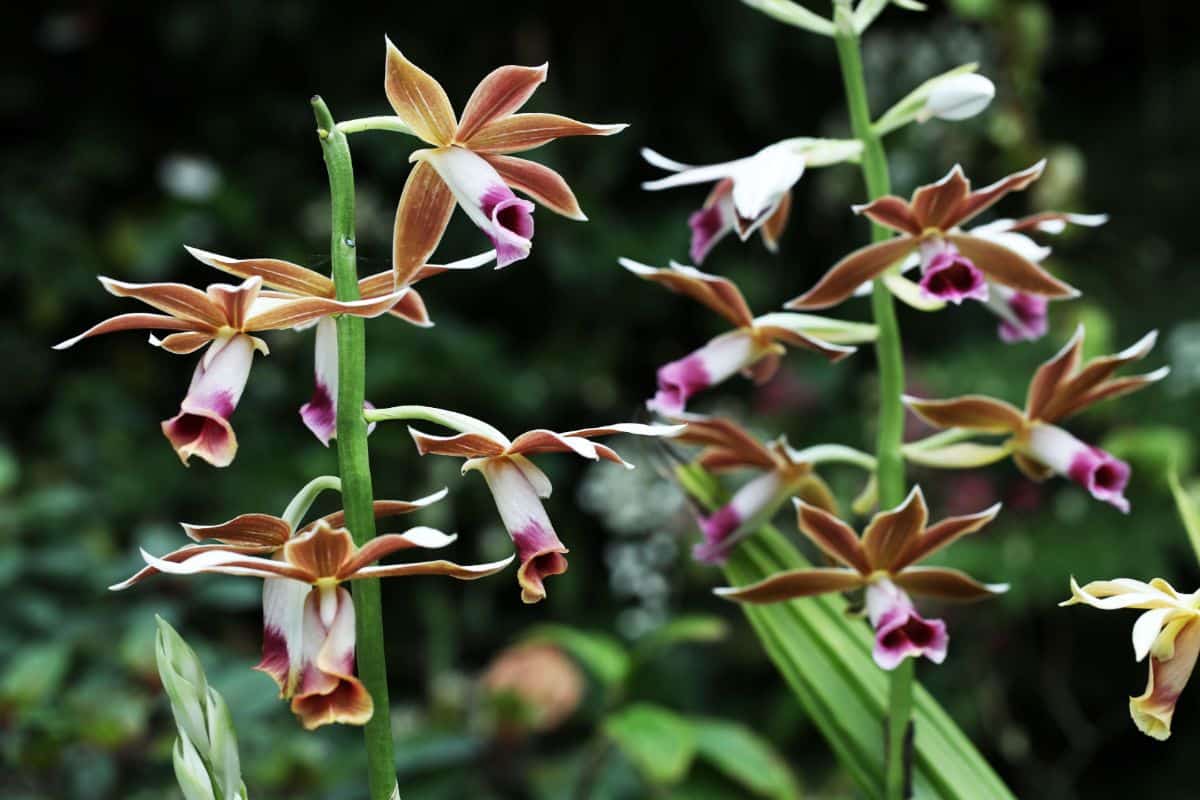
| Plant name: | Nun’s orchid |
| Type of orchid: | Terrestrial |
| Lighting requirements: | Bright, indirect light |
| Watering requirements: | Moderate |
| Minimum humidity level: | 50% |
Nun’s orchids are an interesting orchid type, named for its flower shape, which is said to resemble a nun’s cap. These colorful flowers are pink and brown and appear in profusion, with up to 20 flowers blooming per flower spike. Nun’s orchids are sure to liven up your home with color when they bloom from winter to early spring!
Unlike most orchids, the nun’s orchid is a terrestrial orchid species rather than an epiphyte. That means that it can be potted in standard potting mixes that are usually too dense for other orchid types. These plants can also handle drier soil than other orchids, and soil should be allowed to dry out somewhat in between waterings to avoid waterlogged roots.
5. Dendrobium Orchid (Dendrobium spp.)

| Plant name: | Dendrobium orchid |
| Type of orchid: | Mostly epiphytes |
| Lighting requirements: | Bright, indirect light |
| Watering requirements: | Moderate |
| Minimum humidity level: | 50 to 70% |
The Dendrobium genus of orchids is one of the largest, containing over 2,000 different species. Due to the sheer number of plants in this genus, there is a lot of variety in terms of flower color and leaf shape and form. In general, however, Dendrobium orchids are easy to care for and are faster growing than some of the other orchids on this list.
Another epiphytic orchid, Dendrobiums, should be grown in a well-draining bark mix, and they prefer warm temperatures and bright, indirect light. While some orchids need to be pruned to jumpstart blooming, Dendrobiums usually start blooming after a winter rest period. These high humidity-loving plants should be kept near a humidifier or on a pebble tray to keep them looking their best.
6. Slipper Orchid (Paphiopedilum spp.)

| Plant name: | Slipper orchid |
| Type of orchid: | Mostly terrestrial |
| Lighting requirements: | Bright, indirect light |
| Watering requirements: | Moderate |
| Minimum humidity level: | 40 to 70% |
Slipper orchids are intriguingly shaped plants with rounded flowers that have a pouch of sorts, which is said to look like a lady’s slipper. Flowers generally bloom from mid-autumn to spring, and flowers can last for about 6 weeks. Petals come in a range of colors and are often accented with spots or stripes for even more visual interest.
Slipper orchids should not be confused with pink lady’s slipper orchids (Cypripedium acaule) which are native to North America. Although these plants may look similar, they are completely different species. If you find pink lady’s slippers in the wild, don’t disturb or dig them up because they are slow growing and don’t transplant well.
7. Jewel Orchid (Ludisia discolor)

| Plant name: | Jewel orchid |
| Type of orchid: | Terrestrial |
| Lighting requirements: | Medium to low light |
| Watering requirements: | Moderate |
| Minimum humidity level: | 50 to 70% |
Native to Southeast Asia, jewel orchids have become very popular in recent years and are much easier to find at plant nurseries as a result. Unlike most orchids, jewel orchids are prized for their highly patterned leaves rather than their flower spikes. That said, they do produce pretty, white flowers in fall, winter, or spring.
In the wild, jewel orchids grow on the forest floor, and they should be planted in a well-draining potting mix. A quality substrate for these orchids should be a mixture of orchid potting mix, perlite, and peat moss or coconut coir. When mature, these plants grow to about 12” high.
8. Cockleshell Orchid (Prosthechea cochleata)
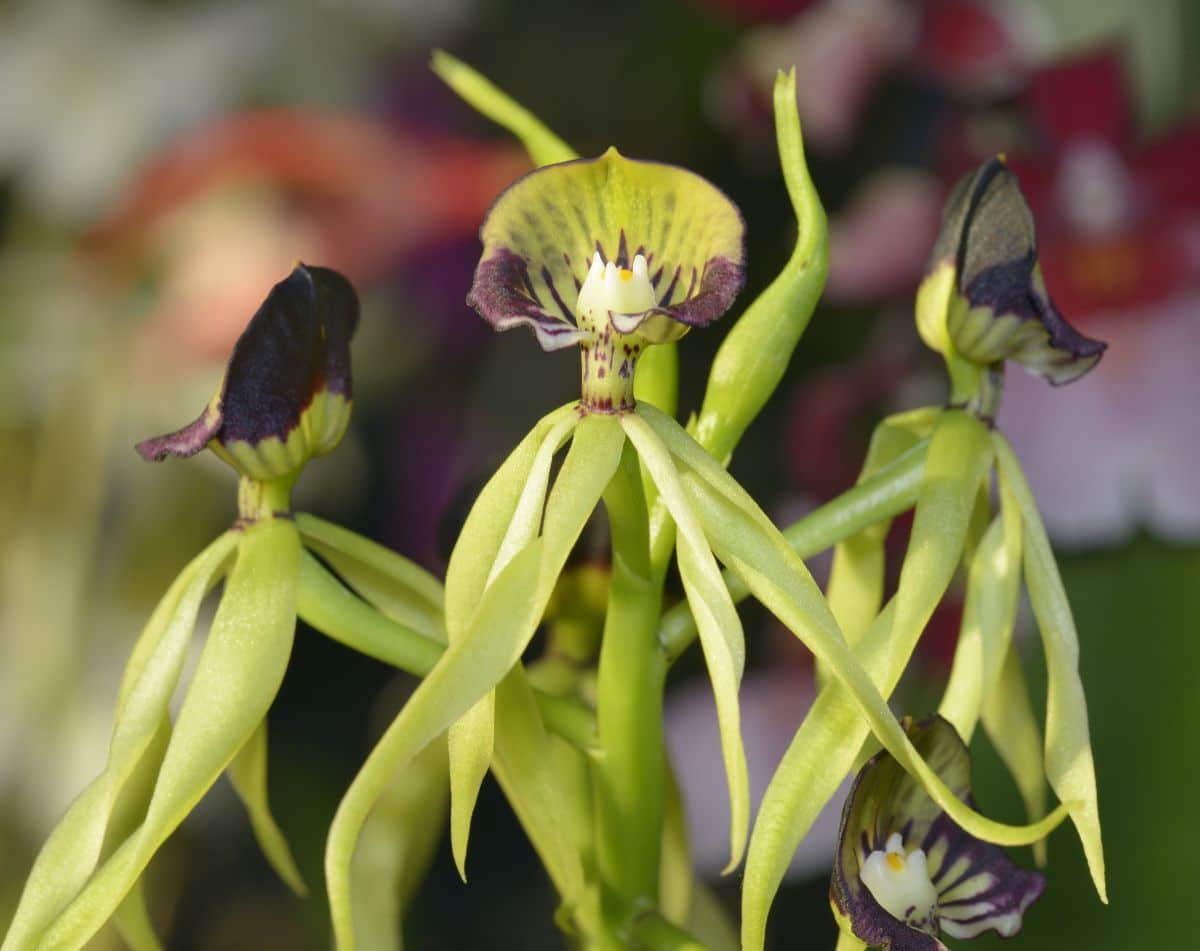
| Plant name: | Cockleshell orchid |
| Type of orchid: | Epiphyte |
| Lighting requirements: | Bright, indirect light |
| Watering requirements: | Moderate |
| Minimum humidity level: | 80 to 85% |
Also known as clamshell or octopus orchids, this striking orchid species has very distinct flowers that have purple, clam-shaped lips atop slender ribbon-like petals which look a bit like an octopus’ tentacles. Flowers usually bloom in spring, but these plants can bloom throughout the year. Even better, the flowers are long-lasting too!
Native to Florida and Central and South America, cockleshell orchids love warmth and humidity. For best growth, try to maintain these orchids at a humidity level of between 80 and 85%. Keeping these plants in grow cabinets can simplify their care requirements as the enclosed environment will help to keep these plants from drying out.
9. Boat Orchid (Cymbidium spp.)
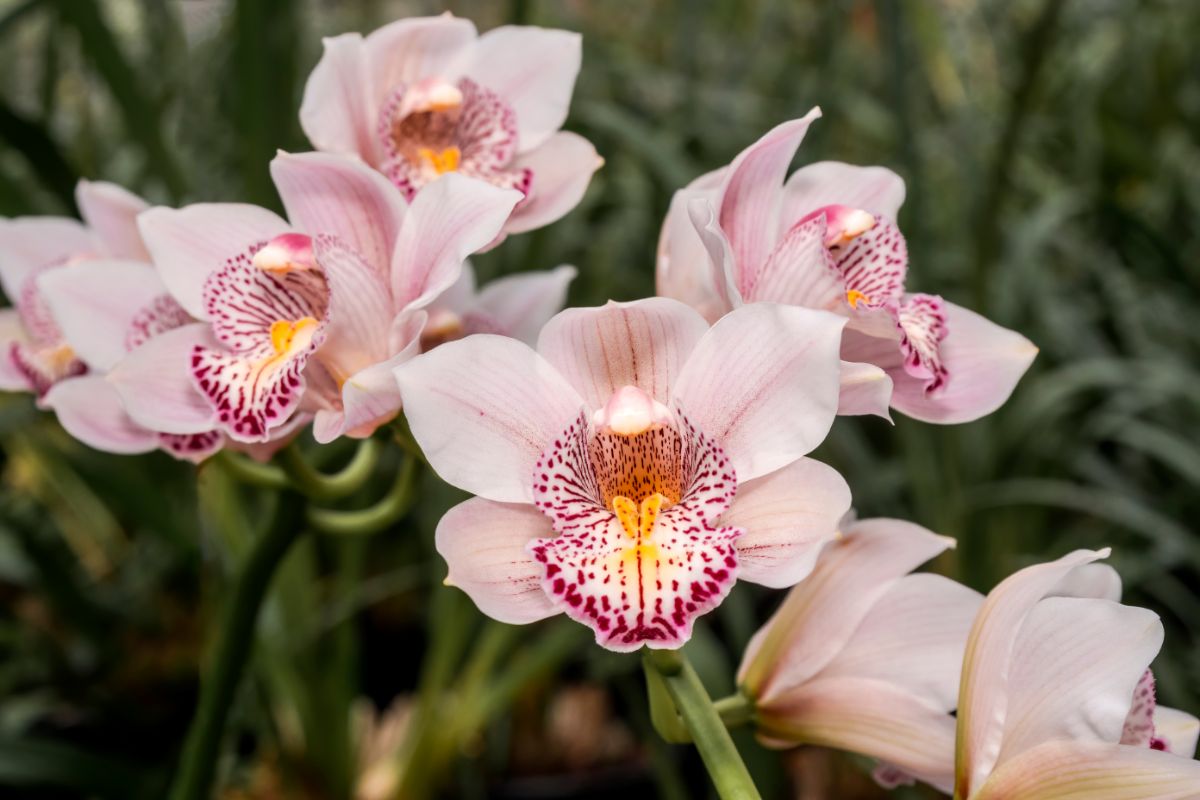
| Plant name: | Boat orchid |
| Type of orchid: | Epiphyte |
| Lighting requirements: | Bright, indirect light |
| Watering requirements: | Moderate |
| Minimum humidity level: | 40 to 60% |
Boat orchids are some of the oldest cultivated species of orchids and have been grown in China for thousands of years. These plants are native to Asia and Australia, where they thrive in spots that are warm during the day and cool at night. While these plants are striking tabletop specimens, they are often grown for cut flowers and corsage making too.
Boat orchids are named for their colorful petals that have a slightly curved shape to them. Like many of the other orchids on this list, these plants grow as epiphytes and do best in bright, indirect light. These adaptable plants can even handle bright sun if they’re grown in cooler spots.
10. Pansy Orchid (Miltonia spp.)

| Plant name: | Pansy orchid |
| Type of orchid: | Epiphyte |
| Lighting requirements: | Bright, indirect light |
| Watering requirements: | Moderate |
| Minimum humidity level: | 50 to 70% |
Pansy orchids are happy-looking plants with wide-open flower heads that have frilly petals that resemble a pansy in form. Native to the cool, tropical forests of Brazil, these plants bloom in early spring, and flowers can last up to 5 weeks. If you’re lucky, your plant may produce a second flush of flowers in autumn as well.
Pansy orchids can be sensitive to salts and chemicals, so you may want to water them with rainwater or aquarium water if possible. Because they are more sensitive, you will also want to be careful when fertilizing them and only apply a small amount of diluted fertilizer to avoid overwhelming your plant.
11. Reed Orchid (Epidendrum spp.)
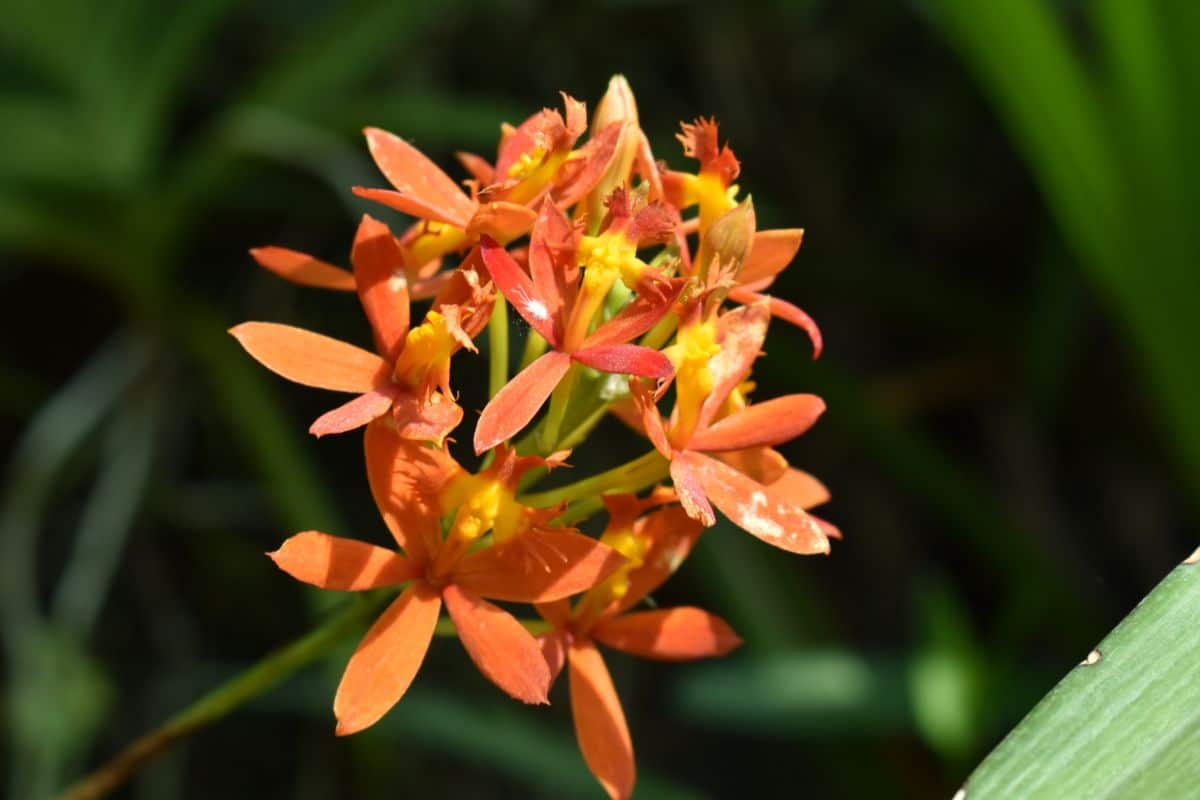
| Plant name: | Reed orchid |
| Type of orchid: | Terrestrial |
| Lighting requirements: | Bright, indirect light |
| Watering requirements: | Moderate |
| Minimum humidity level: | 50 to 70% |
Sometimes called the “poor man’s” orchid, the reed orchid looks a lot like cattleya orchids, although the flowers are smaller. These plants tend to be quite easy to come by, and they are usually budget-friendly too, but they still deliver lots of color and beauty when they bloom! Flowers appear in a cluster at the end of a tall flower spike, and petals range in color from orange to yellow.
Reed orchids should be watered regularly so that the potting mix stays consistently moist but not soggy. Watering should be reduced in late summer or autumn as this plant enters a state of dormancy. Like other orchids, reed orchids are susceptible to aphids and hard-bodied scales, and it’s a good idea to check your plants over from time to time to make sure they stay pest-free.
12. Butterfly Orchid (Psychopsisspp.)
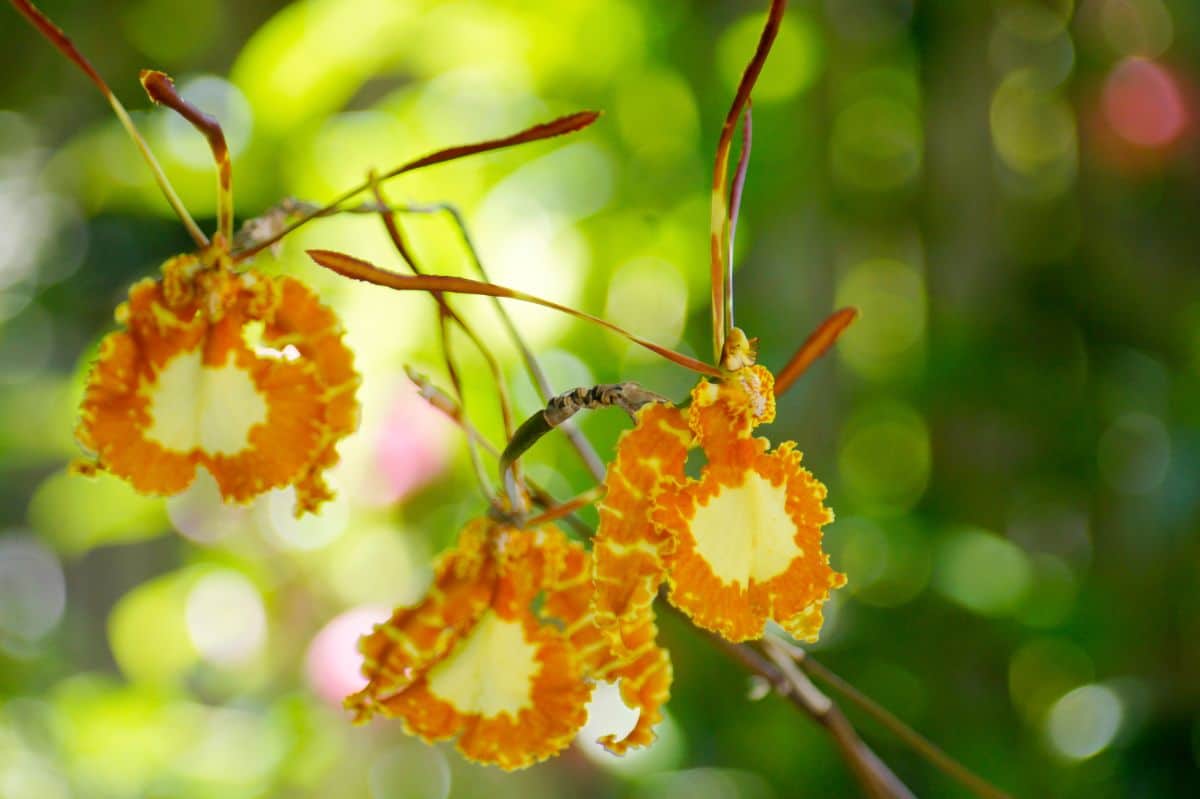
| Plant name: | Butterfly orchid |
| Type of orchid: | Epiphyte |
| Lighting requirements: | Bright, indirect light |
| Watering requirements: | Moderate |
| Minimum humidity level: | 50 to 70% |
Butterfly orchids are very pretty plants with thin and colorful petals that look a bit like butterfly wings. In fact, this plant’s flower evolved specifically to resemble an insect in order to improve pollination rates. In nature, butterfly orchids trick male insects into believing that the flowers are females; however, when they land on the blooms, they end up pollinating the flowers instead!
Indoors, butterfly orchids are very adaptable and hardy. Flowers bloom throughout the year, and multiple flowers can appear on a single flower spike. Once those flowers fade, don’t remove the spike, though, as a single spike can continue to flower for up to 10 years.
13. Dancing Lady Orchid (Oncidium spp.)
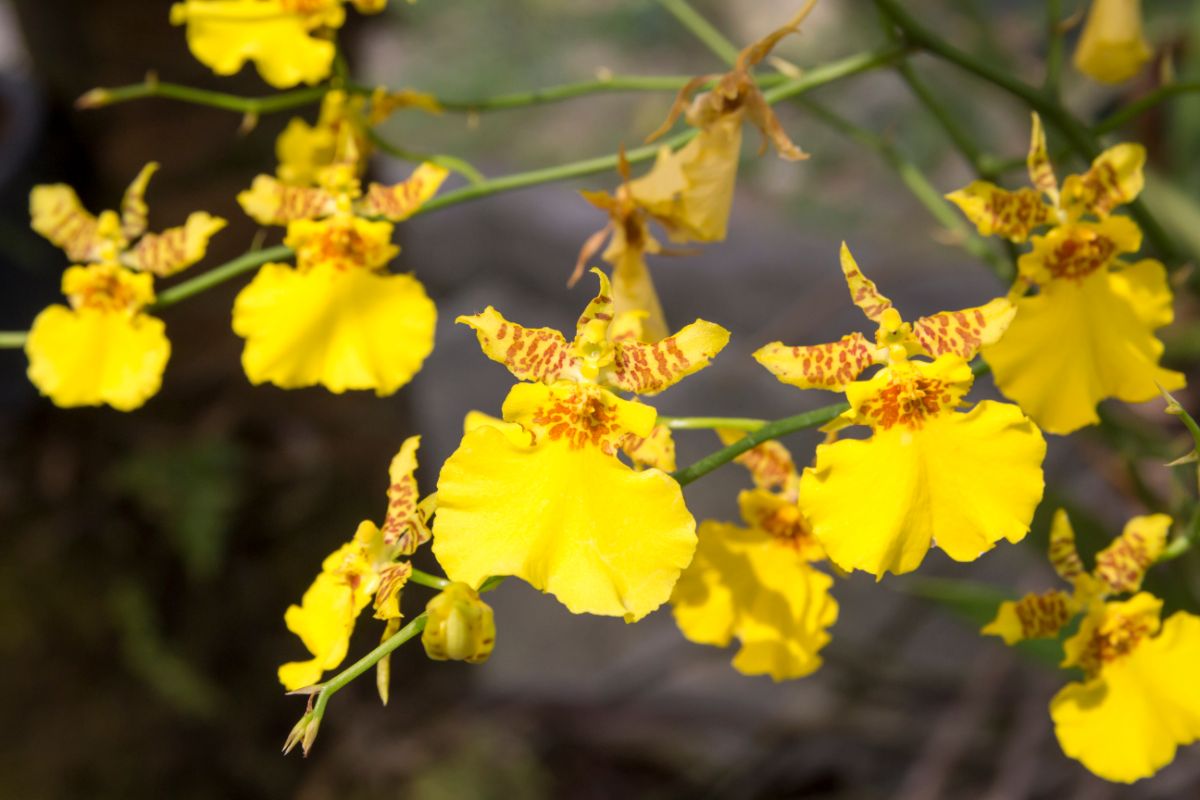
| Plant name: | Dancing lady orchid |
| Type of orchid: | Mostly epiphytes |
| Lighting requirements: | Bright, indirect light |
| Watering requirements: | Moderate |
| Minimum humidity level: | 40% |
Dancing lady orchids produce a profusion of colorful, small flowers with petals in yellow, pink, and purple. These blooms look a bit like butterfly orchids and feature ruffly petals that catch the breeze beautifully. Indoors, these plants are true showstoppers and will add a tropical feel to any collection.
Another epiphytic orchid, dancing ladies, can be potted in bark mulch, or they can be arranged in hanging planters for a more unique look. Provide these plants with bright, indirect sun and plan on watering them about once a week. Dancing lady orchids have lower humidity requirements than some other orchids, but they grow best when humidity levels are between 40 and 60%.
14. Bulbophyllum Orchid (Bulbophyllum spp.)
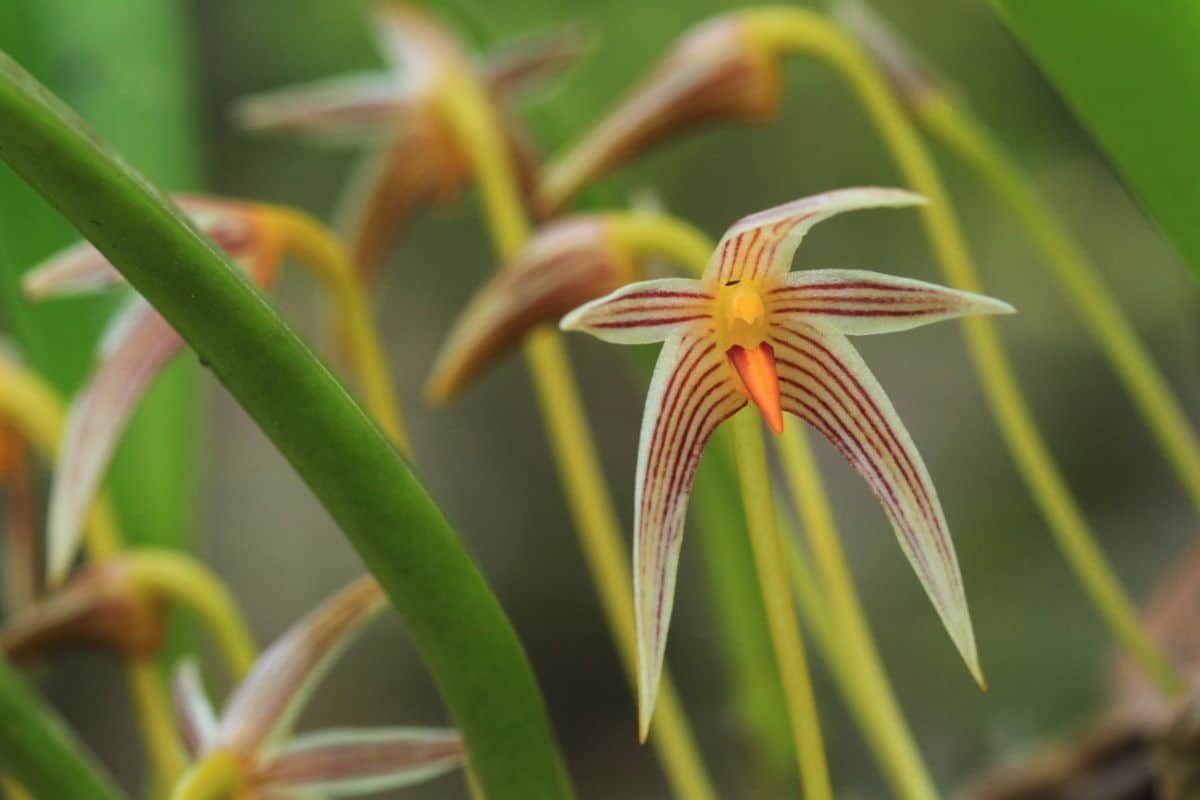
| Plant name: | Bulbophyllum orchid |
| Type of orchid: | Epiphyte |
| Lighting requirements: | Bright, indirect light |
| Watering requirements: | Moderate |
| Minimum humidity level: | 60% |
The Bulbophyllum genus is the largest genus of orchids and contains over 2000 different species. Flower and leaf-forms vary significantly between plants, so it’s difficult to generalize about these orchids. Many Bulbophyllum orchid flowers have a strong scent that is intended to attract flies (this plant’s top pollinator), but some plant keepers may find the aroma unpleasant.
Native to Africa, Asia, and South America, Bulbophyllum orchids grow best in warm temperatures, and they don’t require a period of winter dormancy. Since these plants have slender, fine roots, they benefit from regular misting, and soil should never be allowed to dry out fully,
15. Odontoglossum Orchid (Odontoglossum spp.)
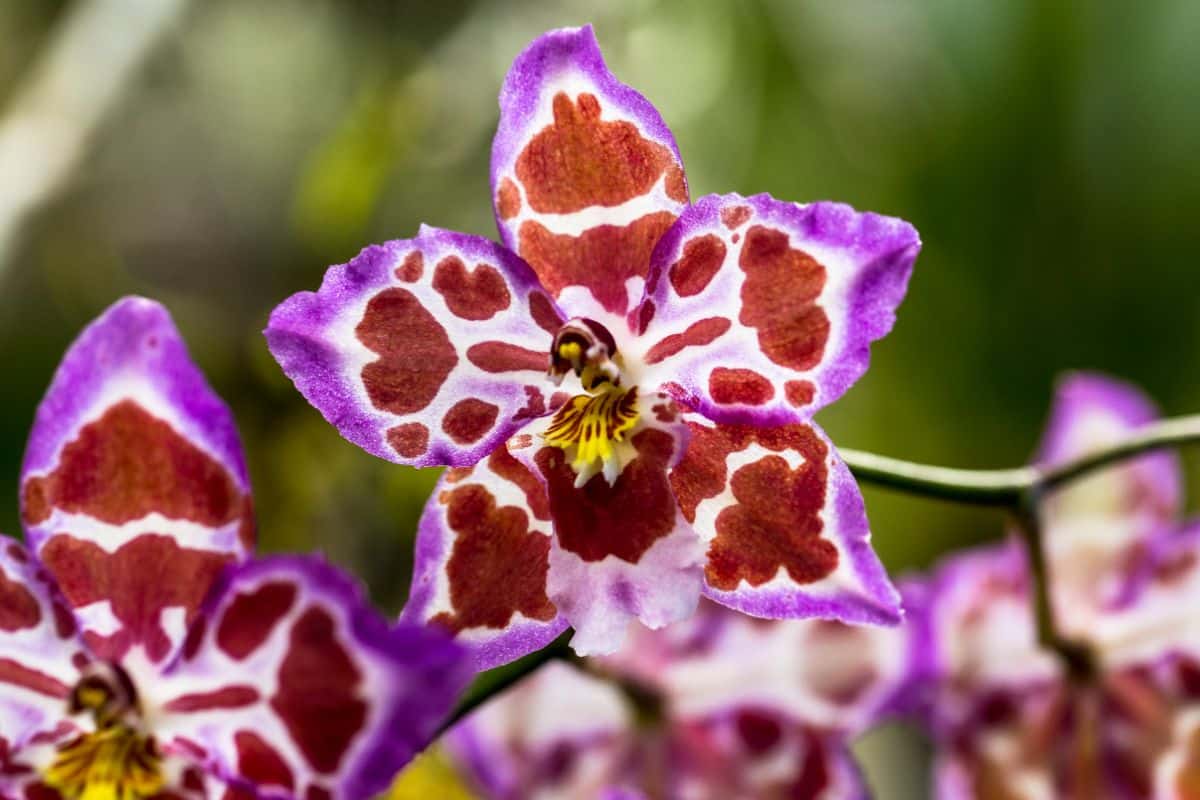
| Plant name: | Odontoglossum orchid |
| Type of orchid: | Epiphyte |
| Lighting requirements: | Bright, indirect light |
| Watering requirements: | Moderate |
| Minimum humidity level: | 40 to 80% |
Odontoglossum orchids are native to the Andes and other mountainous areas where temperatures are cool. This makes them a bit trickier to keep than some of the other orchids on this list, as they do have specific temperature requirements. But, if you’re up for the challenge, they are rewarding plants to keep.
Odontoglossum orchids grow best when daytime temperatures are around 74°F, and nighttime temperatures fall to between 50 and 55°F. If temperatures in your home are warmer than this, you will need to increase humidity levels and water your plant more frequently. For best results, Odontoglossum orchids should be watered lightly, about 2 to 3 times per week.
16. Spider Orchid (Brassia spp.)
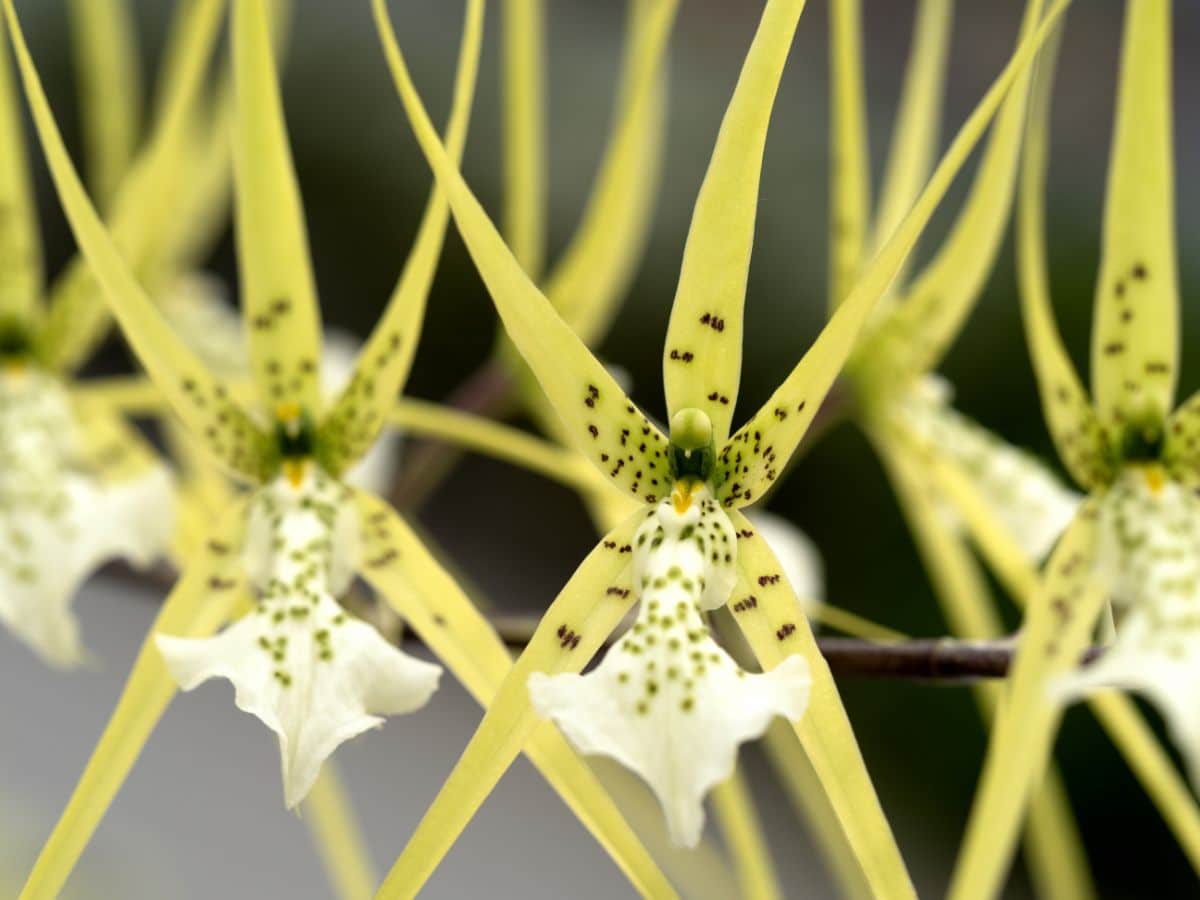
| Plant name: | Spider orchid |
| Type of orchid: | Epiphyte |
| Lighting requirements: | Bright, indirect light |
| Watering requirements: | Moderate |
| Minimum humidity level: | 60 to 70% |
Spider orchids are named for their unique sepals that have a spiky shape, which is said to resemble the slender legs of a spider. Petals are colorful and often patterned with spots and come in pink, orange, and red, as well as other bright colors. Intriguingly, these plants are naturally pollinated by a specific type of wasp, and hand pollination can be a bit difficult.
Spider orchids are found in the wild under dense canopies of leaves, so they don’t grow well in full sun. Instead, give these plants bright, indirect light and never allow the soil to dry out. If needed, fertilize your spider orchid with a diluted, balanced, liquid fertilizer.
17. Christmas Orchid (Calanthe spp.)
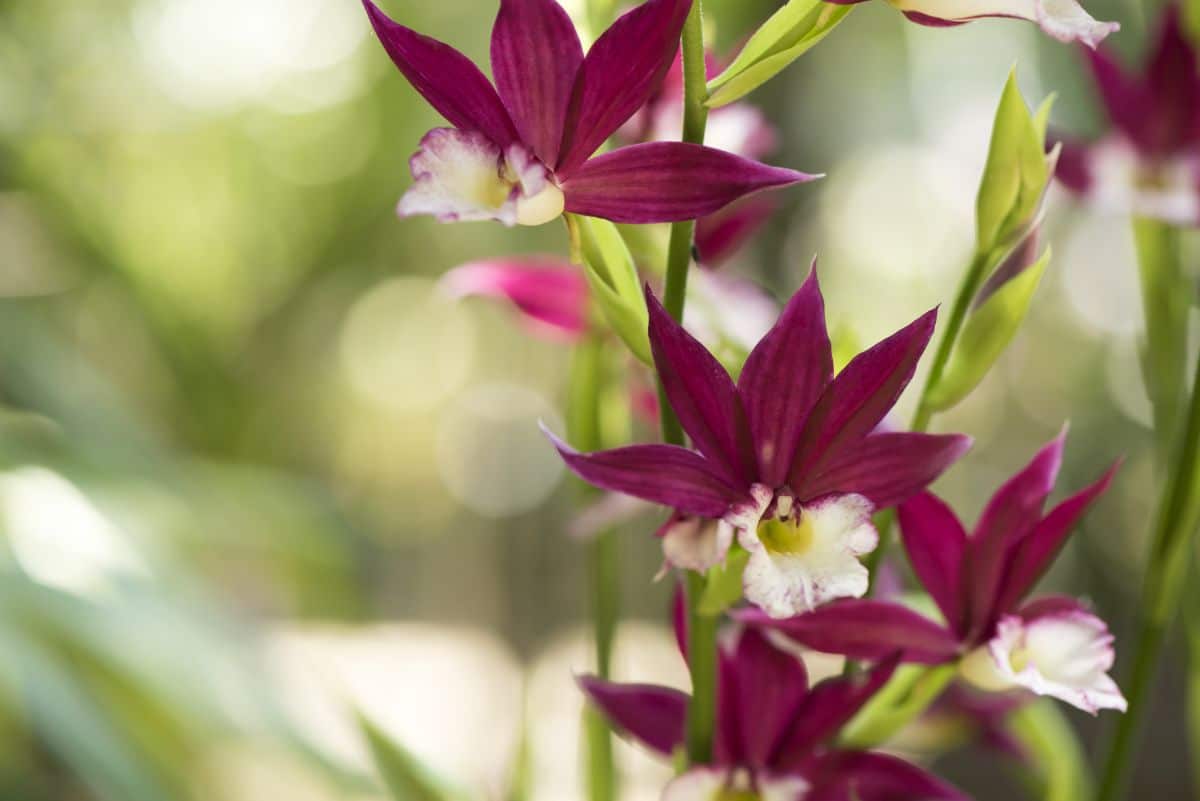
| Plant name: | Christmas orchid |
| Type of orchid: | Epiphyte |
| Lighting requirements: | Bright, indirect light |
| Watering requirements: | Moderate |
| Minimum humidity level: | 40 to 70% |
Christmas orchids are hardy plants that may be able to be kept outdoors in areas as cool as zone 6 as long as they are mulched well. Indoors these plants grow best in dappled light, and they prefer regular watering. In autumn and winter, be sure to reduce your watering schedule significantly to avoid waterlogged roots and issues with rot.
Christmas orchids are named for their bloom time, which occurs in winter. Blooms appear in a range of colors, including red, purple, and yellow, and many flowers feature two-toned petals.
18. Aspasia Orchid (Aspasia spp.)
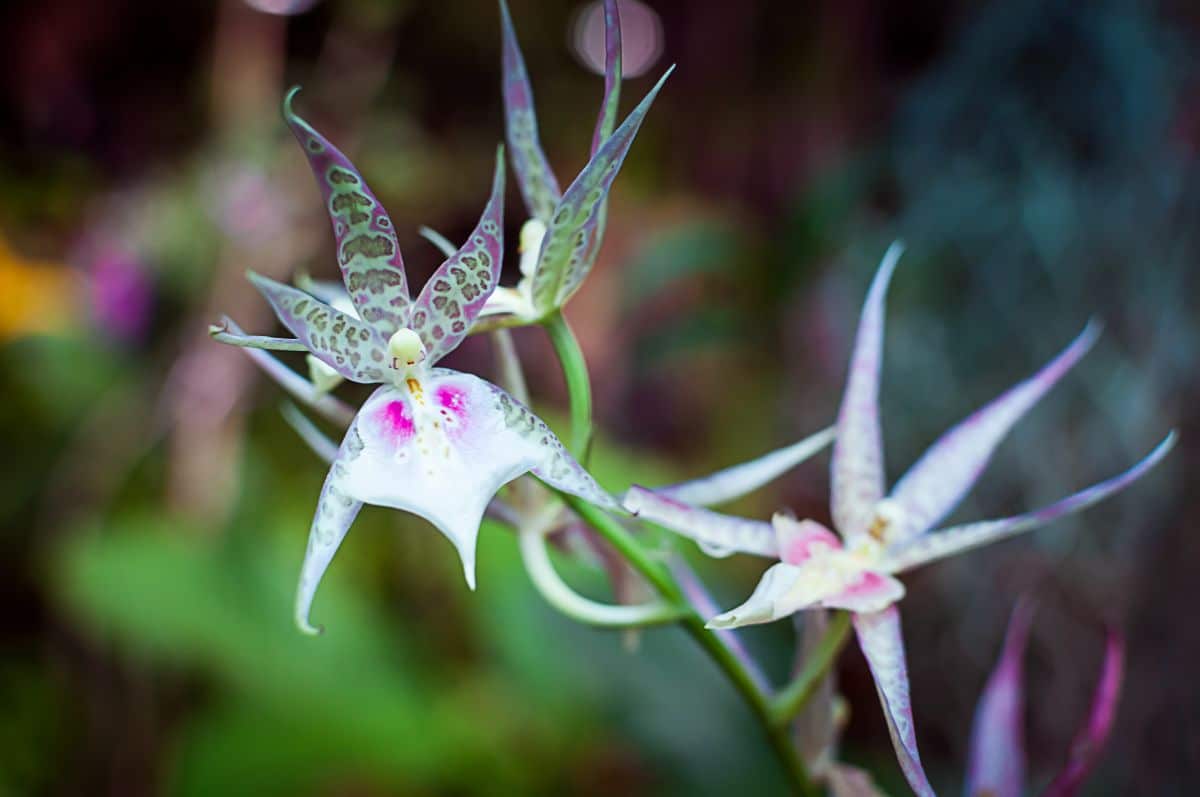
| Plant name: | Aspasia orchid |
| Type of orchid: | Epiphyte |
| Lighting requirements: | Bright, indirect light |
| Watering requirements: | Moderate |
| Minimum humidity level: | 75% |
Aspasia orchids are indigenous to Central and South America and grow as epiphytes in tropical forests. A classic orchid choice, Aspasia orchids are named after the wife of Pericles from Greek mythology.
When mature, Aspasia orchids can produce multiple flower spikes, and blooms usually have purple, white, or brown coloration. These plants should receive regular watering and be kept in high humidity during the growing season, although water can be reduced when growth slows in autumn and winter. For more flowers, fertilize your Aspasia orchid monthly during the growing season with a quality fertilizer intended for orchids.
Frequently asked questions
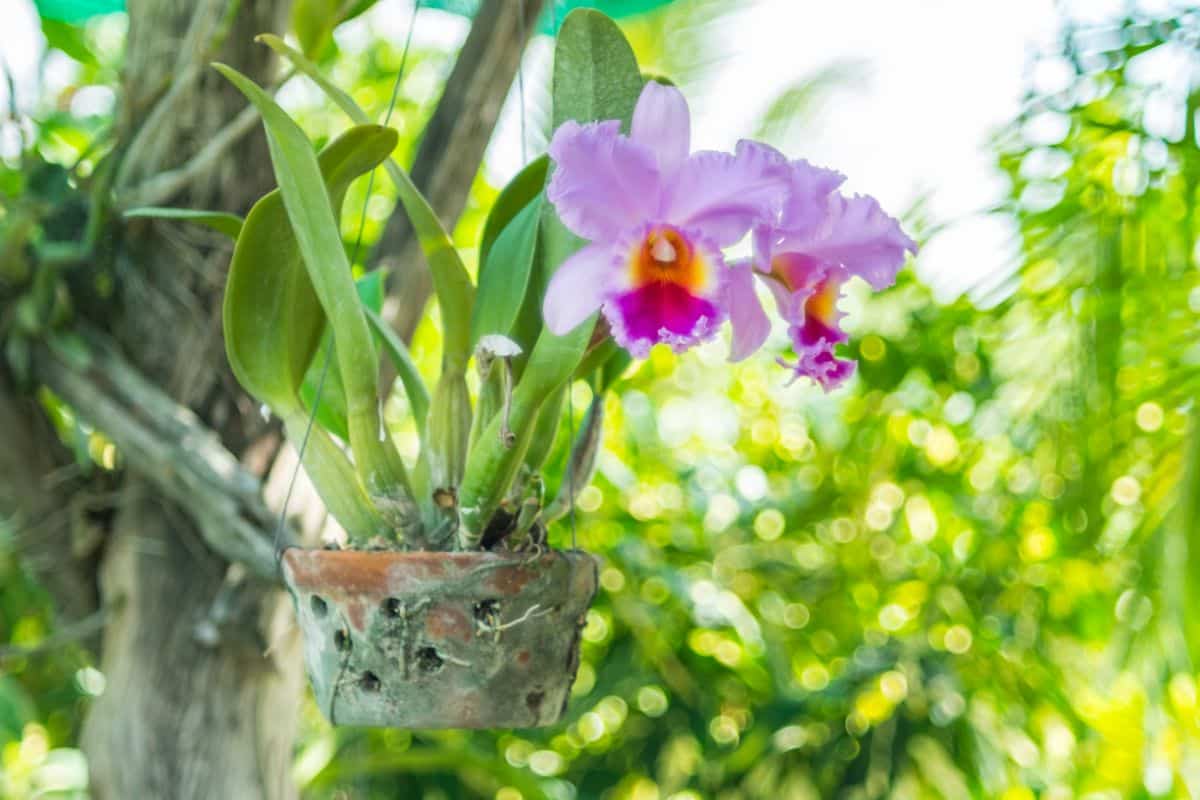
Many orchids require humidity to grow properly, which can be difficult to achieve indoors without the addition of a pebble tray or humidifier. What’s more, many keepers lose interest in orchids when they aren’t in bloom, but orchids will often flower again and again (sometimes even in a single year!)
Moth orchids are well-known for their low maintenance needs and resilience. These plants grow best in bright, indirect light and have lower humidity needs than some other orchid species. If you’re just starting out with orchids, moth orchids are a great species to try.
Some terrestrial orchids may be able to survive in potting soil, but most orchids are epiphytes and cannot be grown in standard potting mixes, which are far too dense for these plants. Instead, opt for well-draining potting mixes intended for orchids. Often, these mixes will contain large quantities of bark mulch and perlite.
Orchids expend a lot of energy to flower, so they do need a period of rest before reblooming. You can increase the chances that your orchid reblooms sooner by ensuring that your plant is receiving enough light and fertilizer.
Some orchid species may produce flowers again and again on a single flower spike. So, it’s a good idea to leave flower spikes in place until they begin to turn brown. Once flower spikes discolor, they won’t flower again.
Orchids that have overgrown their pot push their roots through the potting mix and up into the air. If your orchid has a lot of visible roots, it’s probably time to repot it.
Summary
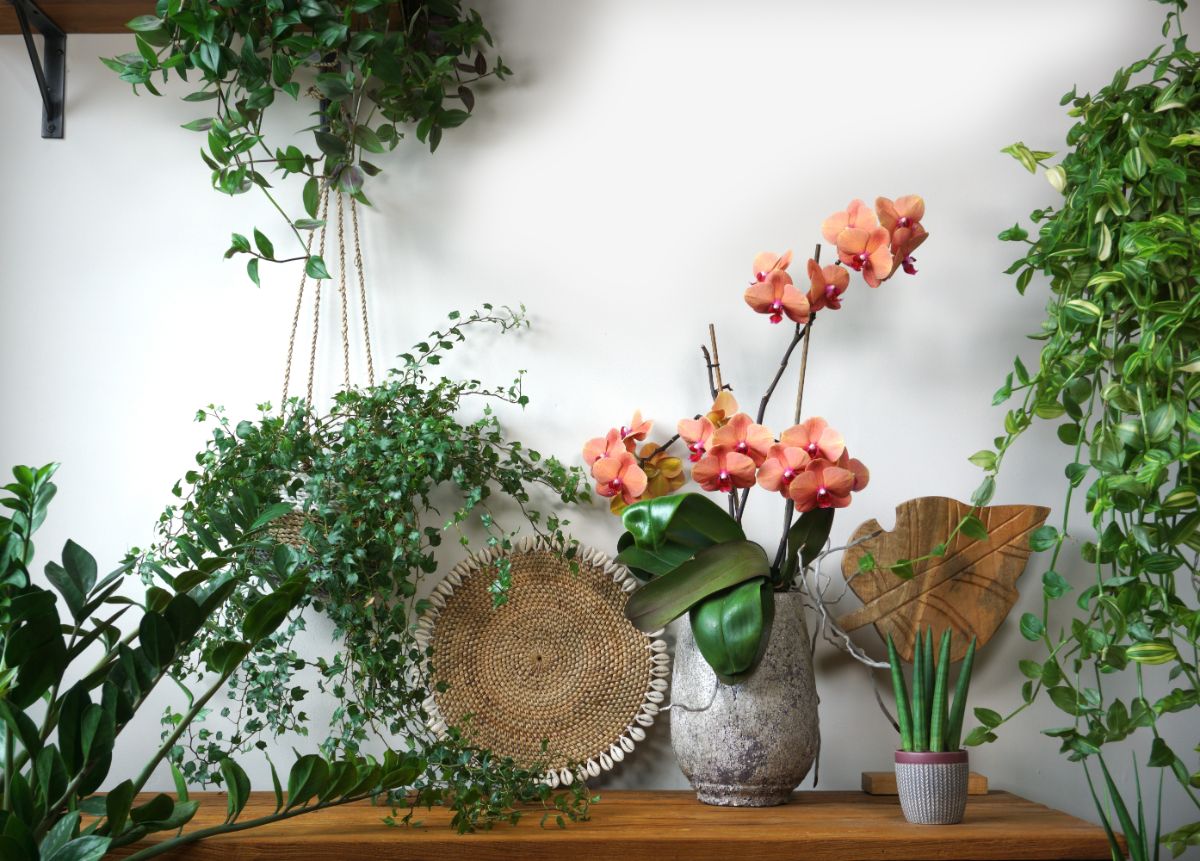
Orchids are stunning plants, but they have a bad reputation for being finicky, and many new plant parents shy away from them. But just as there is a lot of variety in other houseplant families, there are many different species of orchids, and some are quite easygoing.
The key to keeping orchids happy is to ensure that your plants are receiving the right amount of light, water, and humidity for the particular species you’re growing. Once you do this, orchids can be surprisingly easy to care for, and they will reward you for your efforts with lots of beautiful, long-lasting blooms in almost any color you can imagine.
Since most orchids require some humidity to grow properly, if you want to keep orchids at home, you may want to invest in a humidifier. To get you started, check out this guide on the best humidifiers for indoor plants.

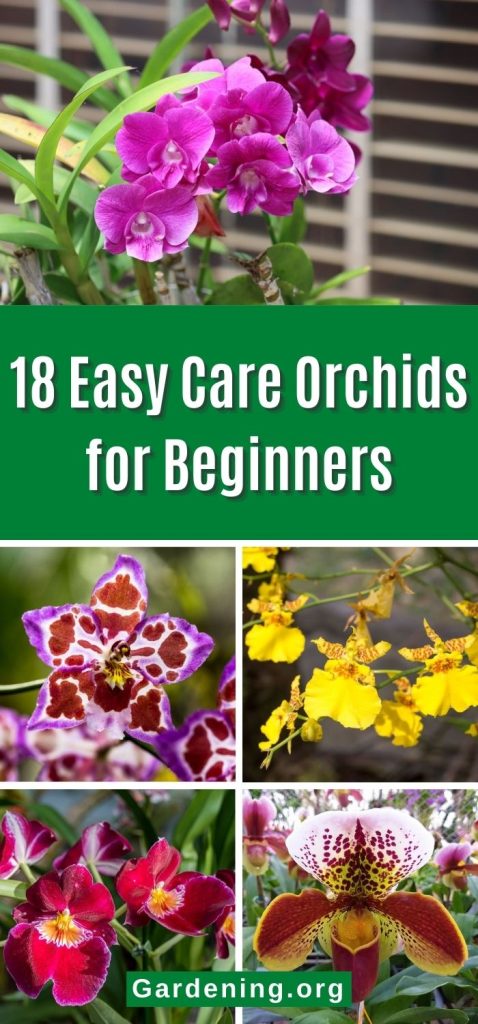
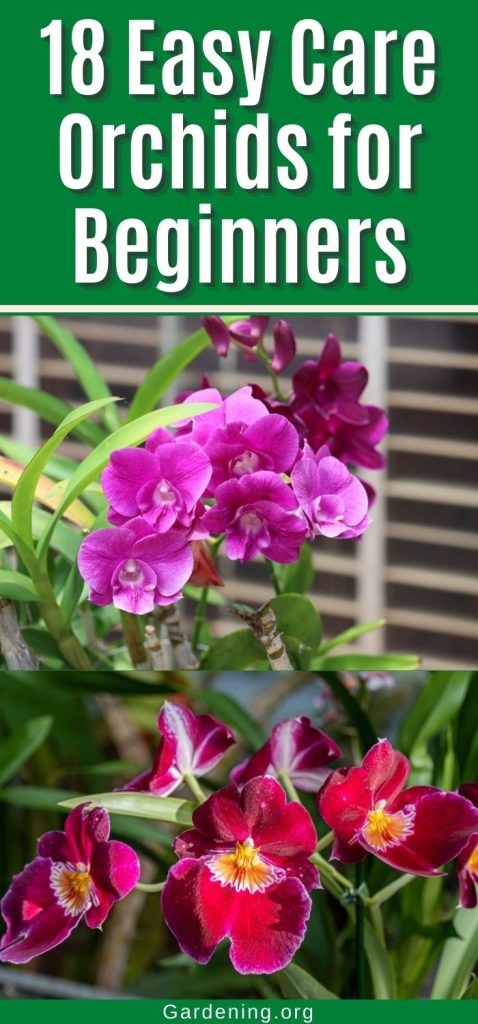
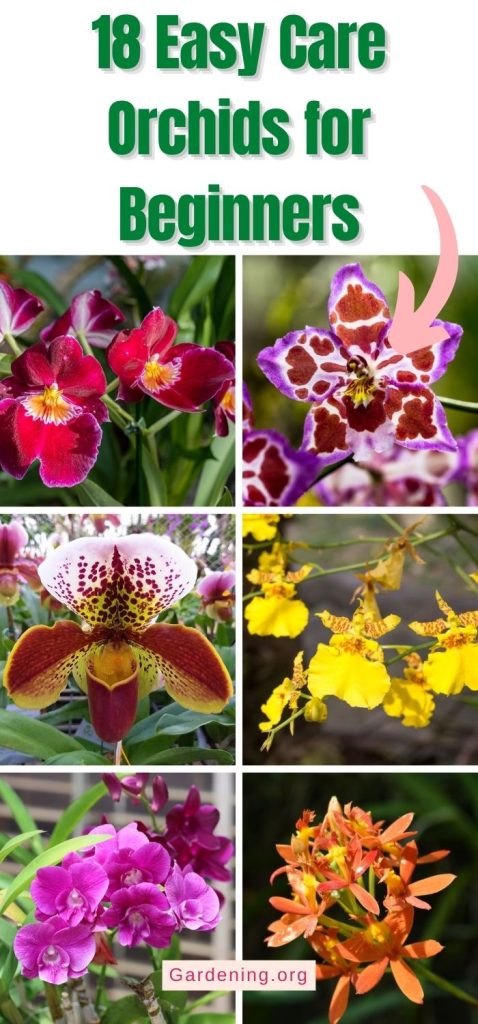
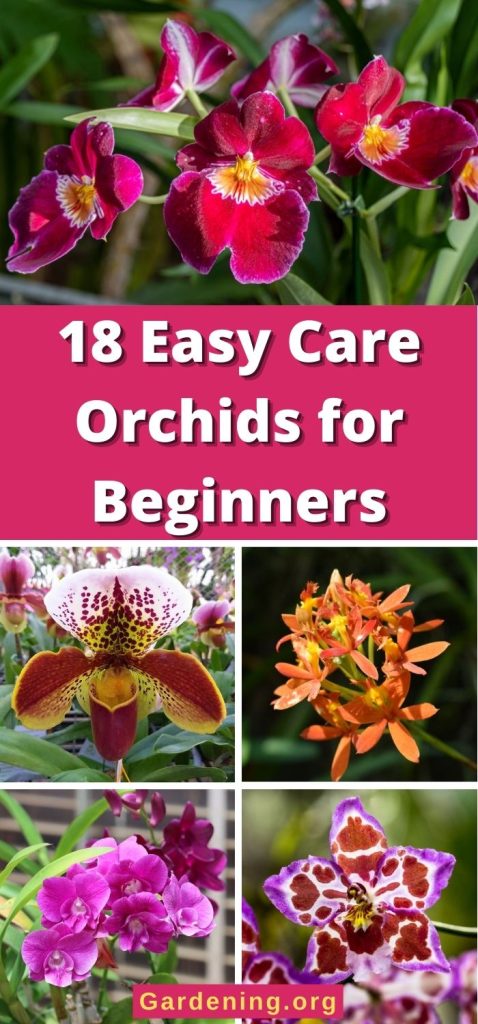
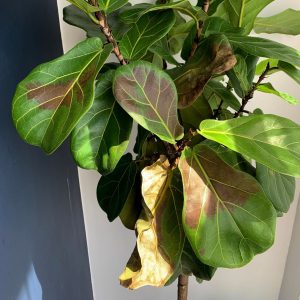
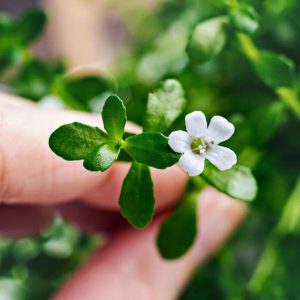
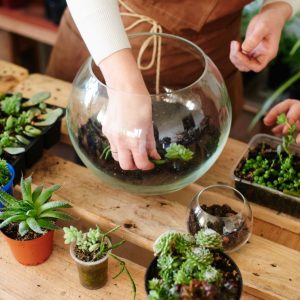
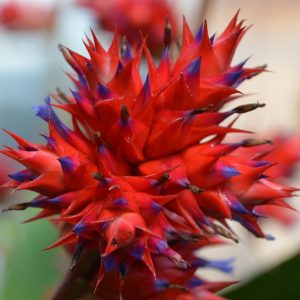
Leave a Reply